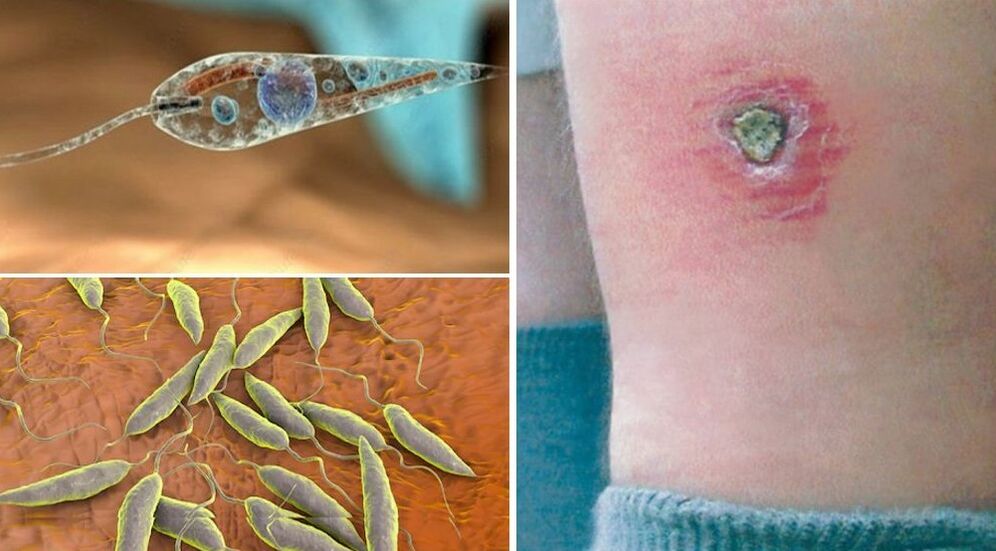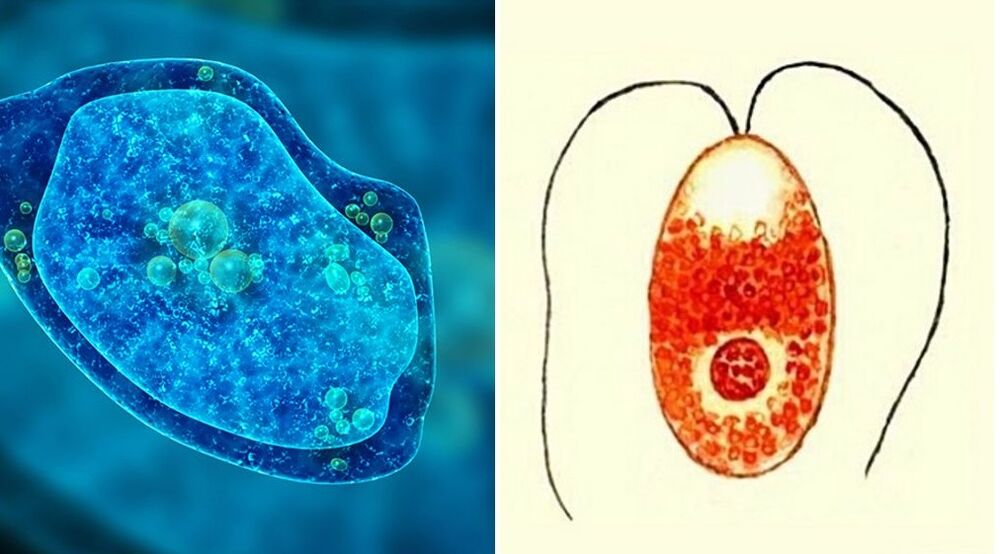Protozoan parasites in humans are the cause of protozoan infections (or protozoa). These diseases are contagious, threatening with serious complications and consequences. Therefore, protozoa requires timely diagnosis, accurate identification of the pathogen and proper treatment.
What are protozoan parasites
This is a group of single-celled microorganisms that are unable to generate nutrients on their own. In the process of life, they use other beings, causing them serious diseases. The most common human protozoan parasites are listed below:
- flagella - Giardia, Leishmania, Trichomonas, Trypanosomes;
- sarcoid - dysenteric amoeba;
- eyelashes - bursa, balantidia;
- sporozoites - Plasmodium falciparum, coccidia, piroplasmas.
Trypanosome
The simplest parasite, whose life cycle takes place in the body of ungulates (antelopes) or an infected person. Carriers are tsetse flies, which, when bitten by humans, inject saliva with protozoa into their skin.
Note!
About 400 trypanosomes are required for the development of the disease (African trypanosome or sleeping sickness). Up to half a million individuals of the parasite fall with a single fly bite.
Characteristics of parasitism and disease:
- trypanosomes initially circulate in the bloodstream of an infected person, causing trypanides on the skin (swelling of the face, eyelids), fever up to 40 ° C, swelling of the lymph nodes;
- then unicellular parasites migrate into the cerebrospinal fluid, causing drowsiness, iridocyclitis, chronic fatigue, lethargy, impaired speech, coordination;
- the advanced form of trypanosomiasis is characterized by convulsions of the limbs, epileptic seizures, nervous and physical exhaustion, respiratory paralysis, coma and death.
Romanovski-Gimza test, immunofluorescence reaction, enzyme immunoassay (ELISA), lymph node puncture are used to diagnose trypanosomiasis. Confirmation of the diagnosis is often done by introducing the blood of a sick person to laboratory pigs. Treatment of sleeping sickness involves taking special medications. In the absence of high probability therapy, a fatal outcome of the patient is possible.
lamblia
Microscopic protozoa (synonyms - Giardia or Giardia) with four pairs of flagella are parasites with a complete cycle in the human body. Under certain conditions, they cause giardiasis. Giardia are attached to the wall of the small intestine with a large sucker, often found in the ducts of the liver, gallbladder and other internal organs.
Note!
Infection with protozoa occurs with food, water, under unhygienic conditions. Giardia cysts with embryos remain invasive in the environment for a long time (up to 3 months in fresh water, up to 4 months in sewage). The diagnosis of protozoa is made by microscopy of cysts and adults in feces, blood, detection of antibodies in the ELISA test.
leishmaniasis
These flagellar protozoa cause leishmaniasis, which is common in tropical and subtropical countries. Infection occurs by transmissible route - when bitten by saliva from blood-sucking insects, animals (dogs, ground squirrels). Carriers can be mosquitoes, gnats, ticks, ticks. There are two types of leishmaniasis in humans:
- skin and mucocutaneous form (pendin ulcer) - leishmaniasis lives and multiplies in human skin, causing inflammation, swelling, ulcers, trophic ulcers, airway damage;
- visceral form - leishmaniasis is found in the internal organs (spleen, liver, lungs, heart).
A characteristic feature of cutaneous leishmaniasis is the formation of brownish nodules (leishmaniasis) at the site of insect bites. They are then replaced by round, difficult-to-heal ulcers with purulent exudate. The disease lasts 1-2 years, leaving scars on the skin. In the visceral form, leishmaniasis causes dysfunction of the adrenal glands, kidneys, liver and spleen. When leishmaniasis is diagnosed, they are found in the bone marrow, lymph nodes, skin scrapings and blood.

Note!
Treatment for leishmaniasis includes quarantine, patient isolation, and medication.
Trichomonas
These are the simplest parasites of the human internal environment, which are sexually transmitted, through domestic contact or as a result of infection at birth from mother to child. There are oral, intestinal and urogenital varieties of Trichomonas. Protozoa are the causes of trichomoniasis / trichomoniasis. Urogenital trichomoniasis of the genitourinary system is widespread. The chronic form of the disease threatens impotence and permanent infertility. Characteristics of the parasitism of Trichomonas:
- body size - up to 18 microns, moves quickly due to movable flags;
- resistant to drugs that determine the chronic course of trichomoniasis;
- they die quickly in the environment, in the air, in direct sunlight;
- stay long on wet towels, sponges, towels, soap dishes;
- frequent infections during sexual intercourse of vaginal, oral-vaginal type;
- Trichomonas contributes to the development of candidiasis, vulvitis, chlamydia, gonorrhea, cystitis.
The diagnosis of trichomoniasis involves the detection of Trichomonas in genital swabs. Treatment includes the use of drugs, treatment with antiseptics. Therapy is performed on both partners to avoid recurrence. Prevention of urogenital trichomoniasis includes measures recommended for all sexually transmitted diseases.
dysenteric amoeba
This sarcoid microorganism is a parasite that causes dangerous diseases in humans. There are two forms of dysenteric amoebiasis - intestinal and extraintestinal (liver or lung). The disease begins 7-10 days after infection with symptoms - bloody diarrhea, fever, vomiting.
If left untreated, the consequences of amoebiasis develop - dehydration, exhaustion, weakness, internal bleeding, liver abscess. Most often the infection occurs orally or faecal route. Carriers of amoeba cysts can be insects - flies, gadgets. Tissue forms of protozoa are found in the stool during diagnosis. The treatment of amebiasis is inpatient, with antibiotics.

Plasmodium falciparum
Representative of the simplest sporozoites, the cause of a dangerous disease - malaria. The human body serves as an incubator where the life cycle of the parasite takes place. Characteristics of parasitism:
- Plasmodium sporozoite infection occurs when bitten by a malaria mosquito;
- sporozoites enter the bloodstream with the saliva of an infected insect;
- sporozoites settle in the liver, penetrate its cells (hepatocytes);
- here merozoites are formed by mitotic replication;
- when hepatocytes are destroyed, merozoites penetrate erythrocytes;
- from merozoites as a result of the sexual cycle gametocytes are formed;
- the mosquito becomes infected with gametocytes when bitten by an infected person;
- in the body of the mosquito gametocytes turn into oocysts and then into sporozoites;
- a mosquito infects a healthy person and the cycle repeats itself.
The destruction of erythrocytes and the release of gametocytes into the bloodstream in humans is accompanied by attacks of fever, vomiting, anemia, convulsions and joint pain. In severe cases, the risk of death increases. Malaria often becomes recurrent with phases of exacerbation and rest. Different protozoa cause tropical malaria, three-day and four-day. The main therapeutic and diagnostic tool is quinine - natural from cinchona or artificially synthesized.
Infusoria balantidia cars
This causative agent of balantidia (or infusional dysentery) lives in the large intestine, causing bleeding ulcers on its walls. Infection with protozoa occurs from domestic animals, mainly carriers of pigs. Characteristics of anatomy and parasitism:
- the body of balantidia is ovoid with a dense, strong shell (pellicle);
- there are many lashes on the surface that serve for movement;
- the sexual form of the parasite is necessary for reproduction by simple division;
- the asexual form (cysts) enters the environment with feces;
- The route of human infection with cysts is oral-fecal.
Migration of protozoa in the intestine in humans is accompanied by headache, vomiting and dyspepsia. The acute stage of balantidiasis is manifested by fever, signs of severe intoxication, rare stools with blood clots. In the absence of timely treatment, a fatal outcome is possible.
Toxoplasma gondii
Crescent-shaped microscopic protozoa of the order Coccidia are widespread in the environment. They are the causes of the disease - toxoplasmosis. In healthy people, ingested pests are destroyed by immune cells. Characteristics of the disease caused by protozoan parasites in humans:
- often toxoplasmosis is asymptomatic, after recovery develops immunity;
- the parasite affects the organs of vision, reproductive, nervous, lymphatic systems, liver, spleen;
- during pregnancy toxoplasmosis causes severe congenital pathologies of the fetus or its death;
- the acute form occurs with convulsions, paralysis, hypertrophy of the liver, heart problems;
- in chronic course, heart dysfunctions, damage to the organs of vision are possible.
The main hosts of protozoa are cats. Oocyst colonies form huge colonies of Toxoplasma in their bodies. Humans are intermediate hosts, infected through food, contact or oral-fecal route.






































